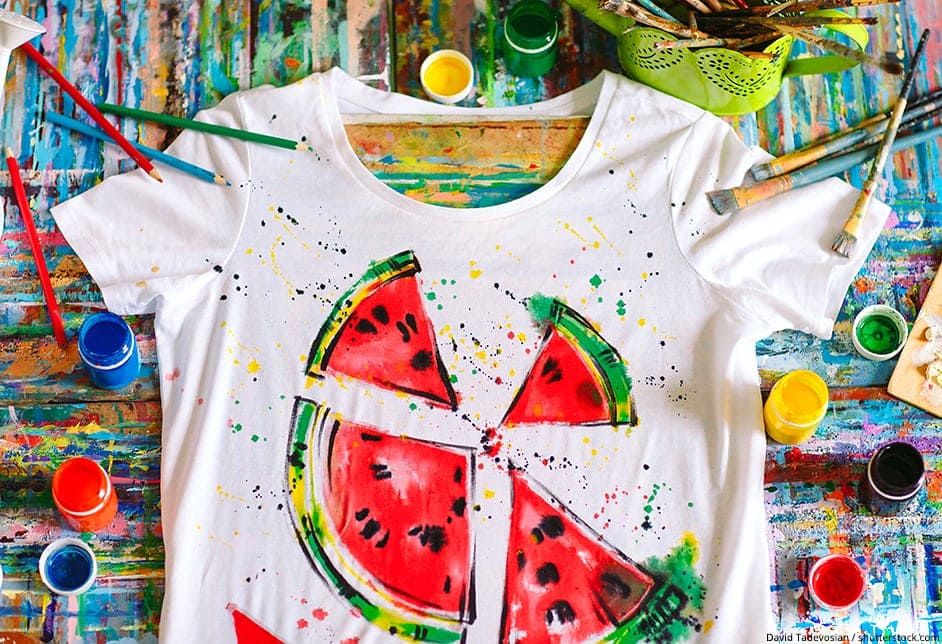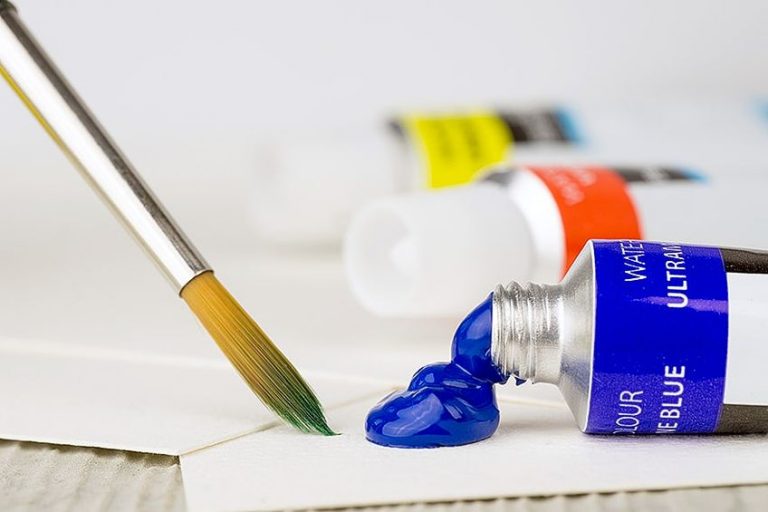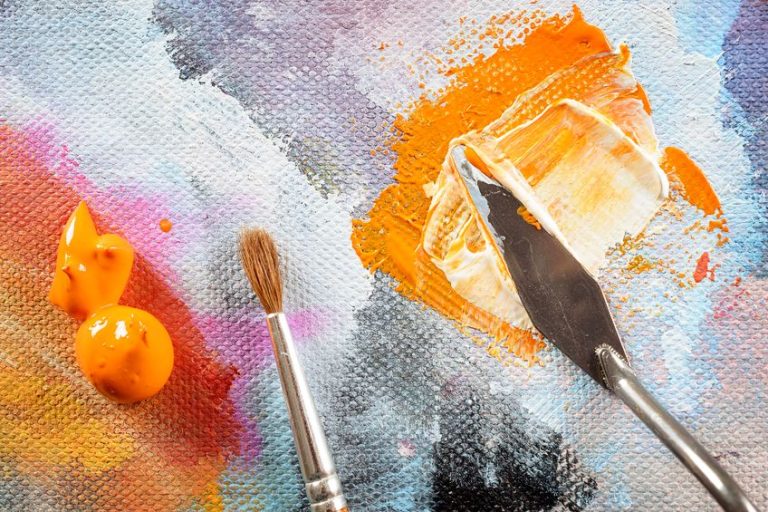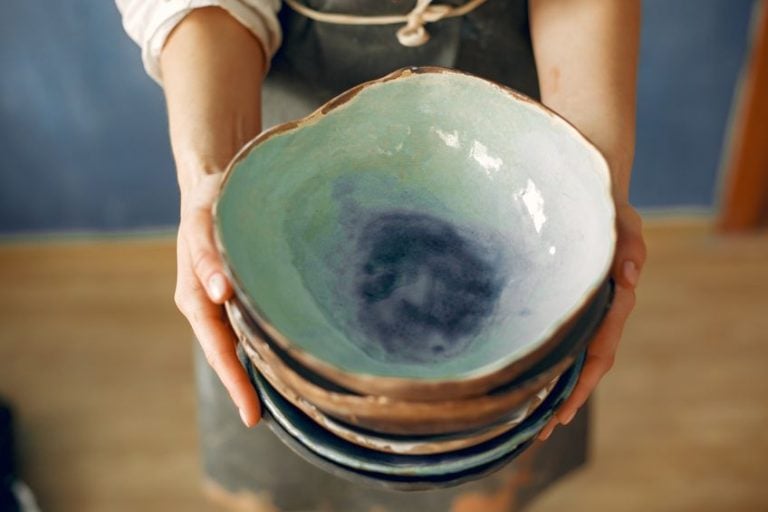Acrylic Paint on Fabric Tutorial – Step-by-Step Instructions
Using acrylic paint on fabric is an easy option for crafting and refurbishing old or outdated clothing. However, not all acrylic paints are fabric-friendly, meaning they may damage your fabrics or not hold properly to the material if you do not use the correct paint and tools. In this article, we are going to cover all the tips on using acrylic paint on fabric and how to get the best results.
Table of Contents
Can You Use Acrylic Paint On Fabric?
Acrylics are a wonderfully versatile medium that can be used on most surfaces, but a common question is: can you use acrylic paint on fabric? As we know, canvas is a common option when painting with acrylics and these are made from material. This implies that acrylics would work well on other fabrics too.
Some items you could include in your painting projects would be shoes or pillowcases. You may then be brave enough to try acrylic painting on clothes. When using your acrylics for fabric there are a few things you will need to remember, it is not as simple as just applying paint.

Using An Acrylic Fabric Medium
When working with acrylic on fabric, one will ideally need a fabric medium to work with, this essentially turns your acrylics into fabric paint. Using this medium ensures that your paints will hold well to the fabrics and will not wash out or fade after use. A fabric medium also adds a softer feel to the acrylics, so that your materials will not stiffen when dry.
Another benefit to using these mediums is that they can alter the consistency of your acrylics without the worry of running or bleeding through your materials. A fabric medium also allows one to explore different blending techniques or even watercolor effects. This opens up a whole array of exciting creative projects one can use acrylic paint on fabric for.
Using an acrylic fabric medium also allows for more creative use of techniques and tools. You could add stencils or use household objects to gain different textures on your fabrics. The best thing about painting on fabrics with acrylics is that they come in a wider range of color options to choose from than most fabric-specific paints.
Tips For Using Acrylic On Fabric With A Medium
If you would like to use a fabric medium with your acrylics, then here are some great tips to check out.
- Before starting you may want to place a protective layer over the surface you will be working on. This could be some newspaper, a thick board, or even an old sheet. This will prevent your fabrics from sticking to the surface while you are painting.
- Always pre-wash the item you plan on painting. This not only removes dirt and dust but will also prevent shrinkage when washed in the future. Leave your item to dry fully before starting with any paint.
- Once your item is dry, you may want to stretch it out using some board or other household item. This step would be useful when using acrylic paint on clothing and will make it easier to paint the area. keep it stretched until you are done with your painting.
- Make sure the fabric you have chosen can handle acrylic paints. These fabrics would include cotton, silk, cotton blends, wool, terry cloth, felt, velvet, flannel, suede, corduroy, leather, and most other synthetic material and blends.
- Now you can add your fabric medium to the acrylics and mix them until you are happy with the consistency.
- Always test your paint on a small area or separate piece of fabric to see how it reacts.
- Once you are done, leave the artwork for a day or so to dry completely.

Using Acrylic Paint On Fabric Without Medium
There is the option to use your acrylic paints on fabric without the use of a medium. This will however not produce the same results. The benefit of using a fabric medium is that they allow your fabrics to retain their soft feel and flexibility. If you apply acrylics directly onto fabrics, they often produce a stiff feel, and they will be washed off when you do laundry. The other risk you take on when just using the acrylics alone is that even if you do not wash the fabrics, the paint may crack or peel off easily as there is nothing to bind it to your fabric fibers.
Whether you are painting a pair of shoes or a decorative cushion, a fabric medium will certainly extend the durability and longevity of your fabric projects. If you are planning on doing more of a wall hanging or even a tapestry, then you may be more inclined to not use a medium as there is no wear and tear. Just keep in mind that sunlight, dust, and other elements could have a damaging effect on these too.
Tips For Using Acrylic Paint On Fabric Without Medium
If you have opted not to use a fabric medium with your acrylics, then here are some handy tips to ensure you still get the most out of your fabric projects.
- Instead of washing the fabric first, you are going to sand it. Using a small piece of sandpaper lightly go over your fabric to remove any loose bits or dust pieces.
- Now using a spray bottle you are going to lightly wet the fabric. Make sure to not saturate any areas and to make an even application over the entire piece you are painting. the moisture in the fabric will allow your acrylics to better adhere and be absorbed once dry.
- Now you can start painting. it is easier if you add some water to the acrylics and thin them before applying. This will make them more workable and hopefully, your final product will not be so stiff when it dries.

After Care Tips When Using Acrylic Paints On Fabric
No matter if you have used a fabric medium or not, there are still some great after-care tips you can use to extend the longevity of your fabric art.
- If you have used a fabric medium, then you should be able to wash your painted clothing and fabrics as normal.
- If you have not used one, then you should not get your fabrics very wet. Ideally, spot cleaning is best for these fabrics so as not to ruin or wash away your paints.
- Try not to wash your items too often as with every cycle you may run the risk of fading. That being said, a cold wash cycle is best when washing painted fabric items.
- After painting your fabrics you should ideally wait around four days before attempting another wash.
- If you are hesitant to use the washing machine even on a cold cycle, then handwashing is a great option just be sure to only use cold water.
- Ironing on your fabrics is also doable, as long as you are using a low heat.
How To Use Acrylic On Fabric
Now for the fun part! Here we will discuss how to use your acrylic paint on fabrics as well as some fun ideas to try.
- Always lightly and evenly wet the fabric you are using to ensure the best possible coverage and absorbency.
- An acrylic fabric medium or flow additive will increase the flexibility and workability of your paints.
- Using tight woven fabrics like silk or cotton will produce the richest colors and durability.
- A hot wax can be used for any hard edges on your fabrics. This can later be removed by dry cleaning.
- Try using different cake nozzles on your acrylic paints for fun and interesting designs. These can be used to create thinner or thicker lines and textures.
- If you are drawn to watercolor effects then try using more water or fabric medium with your paints to thin them out.
- Using lighter fabrics will aid your paint in spreading and you can then move them around or create various effects.
- Applying thin layers can create different textures without changing your colors. This will only work if you allow each layer to fully dry in between.

Using Heat or Heat Setting Acrylic Paint on Fabrics
Using acrylic on fabric can be prone to wash off or fade over time. This is why some people like to set their items using heat. Some prefer this method while others do not find it necessary. Whether or not you decide to heat set your items will depend on the project you are doing and the fabrics you are using. When acrylic painting on clothes for example this may be useful.
The benefit of setting your fabric with heat is that it retains the designs better and will then last much longer, especially when items are going to be washed in the future. The heat actually seals your paint into the fabric. The typical way to do this is to use an iron at home. Below we will walk you through this process.
- When you have done your fabric painting leave it to dry for at least a full day before attempting any further work. If you apply heat too soon your paint will be affected and your project ruined.
- The first tip to remember when using your iron is to turn off your steam setting. Adding any moisture to the fabric at this stage will be highly unproductive.
- Make sure your heat is on low, if it is too hot this will burn your paint or material.
- The key when doing this step is to keep moving. Do not leave the iron on any one area too long as it may burn your fabric.
- Keep moving slow and steady allowing the heat to seal in all elements that are painted. Try doing smaller sections at a time. You want to do this for up to five minutes.
Frequently Asked Questions
Can Acrylic Paint Be Used On Fabric?
Yes, acrylic paints are a highly versatile medium that can be used on many surfaces. Fabrics that hold acrylics well include cotton, silk, velvet, suede, corduroy, and many more.
How To Use Acrylic Painting On Clothes?
The best way to use acrylics on clothing and other fabrics is to use a fabric medium. This essentially turns your acrylics into fabric paints. Making them hold well and not bleed through your materials.
Can You Use Acrylic Paint On Fabric Without Medium?
Using acrylic paint on fabric without mediums is doable but it will not produce a soft or natural effect. The acrylics by themselves often turn fabrics stiff and they may even run or bleed through your material. The best way to paint on fabric without a medium is to lightly wet your fabric before starting.
And there you have it! All you need to know to get you started with painting acrylics onto fabrics. We hope you enjoy your fabric painting projects.
In 2005, Charlene completed her Wellness Diplomas in Therapeutic Aromatherapy and Reflexology from the International School of Reflexology and Meridian Therapy. She worked for a company offering corporate wellness programs for a couple of years, before opening up her own therapy practice. It was in 2015 that a friend, who was a digital marketer, asked her to join her company as a content creator, and this is where she found her excitement for writing.
Since joining the content writing world, she has gained a lot of experience over the years writing on a diverse selection of topics, from beauty, health, wellness, travel, and more. Due to various circumstances, she had to close her therapy practice and is now a full-time freelance writer. Being a creative person, she could not pass up the opportunity to contribute to the Art in Context team, where is was in her element, writing about a variety of art and craft topics. Contributing articles for over three years now, her knowledge in this area has grown, and she has gotten to explore her creativity and improve her research and writing skills.
Charlene Lewis has been working for artincontext.org since the relaunch in 2020. She is an experienced writer and mainly focuses on the topics of color theory, painting and drawing.
Learn more about Charlene Lewis and the Art in Context Team.
Cite this Article
Charlene, Lewis, “Acrylic Paint on Fabric Tutorial – Step-by-Step Instructions.” Art in Context. March 21, 2021. URL: https://artincontext.org/acrylic-paint-on-fabric/
Lewis, C. (2021, 21 March). Acrylic Paint on Fabric Tutorial – Step-by-Step Instructions. Art in Context. https://artincontext.org/acrylic-paint-on-fabric/
Lewis, Charlene. “Acrylic Paint on Fabric Tutorial – Step-by-Step Instructions.” Art in Context, March 21, 2021. https://artincontext.org/acrylic-paint-on-fabric/.









